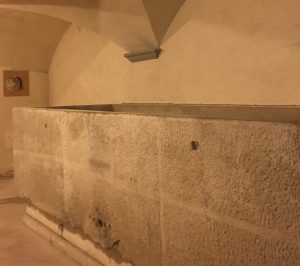Santa Maria Nuova’s Open House & the Da Vinci Legend
 Within the halls of Florence’s oldest hospital, a rich history traces Santa Maria Nuova’s lowest level, reminding locals and tourists alike that the building is more than a medical facility. Currently celebrating its 730th anniversary, the hospital is as active now as it was in the 13th century. But through the entrance, past the café, and down a hallway overlooking a courtyard, a door remains shut, hiding clues to the hospital’s past from any unassuming visitor or patient.
Within the halls of Florence’s oldest hospital, a rich history traces Santa Maria Nuova’s lowest level, reminding locals and tourists alike that the building is more than a medical facility. Currently celebrating its 730th anniversary, the hospital is as active now as it was in the 13th century. But through the entrance, past the café, and down a hallway overlooking a courtyard, a door remains shut, hiding clues to the hospital’s past from any unassuming visitor or patient.
But for the few invited through the door—as of now, the hospital’s lower levels restrict public access, though anyone can visit the museum itinerary—a staircase descends into an empty corridor. Visitors follow a path that weaves through the hospital’s underground and opens into a dim passageway on the right-hand side. The entrance leads into a vaulted room where three large basins line the walls. Made of sandstone, the basins extend from 3 to 4.6 meters long and 1 meter deep. Not just any tubs, these basins supposedly connect to Leonardo Da Vinci’s past and indicate the autopsy work he allegedly conducted in the hospital’s basement. A showcase for these 16th century artifacts, Santa Maria Nuova offers a brief peek into the renowned artist-scientist’s past.
While it is not confirmed that Leonardo actually used the basins in the basement, the tanks are known as Leonardo’s tubs: a title that affirms the importance of preserving and opening the hospital’s hidden areas. With 730 years as a hospital, the foundation hopes to recover the underground hospital path and is initiating projects to preserve the lesser used areas of the hospital.
For the public, a party will be held on June 23 to celebrate the history of the hospital with an entire day’s worth of festivities. The day’s activities include a book presentation dedicated to Dr. Ilaria Meucci, a meeting with the hospital’s staff about the history of the building, and a presentation of plaques for retired hospital employees. For those interested in the artistic side of the hospital, the Santa Maria Nuova Onlus Foundation will offer guided tours of the hospital museum beginning at 7 pm. Admission is free, and the foundation will not take reservations. Following the tours, the Church of Sant’Egidio will host a concert at 9 pm, featuring singer Anna Auri, cellist Luca Paccagnella, and pianists Manuel Malandrini and Yirui Weng.
In addition, the Italian post office has issued a special stamp for the hospital’s anniversary. The stamp will be available for purchase Saturday at the hospital’s entrance.
While many historians argue that Leonardo did not, in fact, use the tubs, the legend has pierced the hospital’s history and provided an alleged backstory for a building already permeated with history. In 1288, Monna Tessa, the governess of Beatrice Portinari, the great love of Dante’s life, convinced Beatrice’s rich banker father, Folco, to finance a hospital for the city’s poor. Thanks to its wealthy patrons, Santa Maria Nuova gained power as an institution and was endowed with many important works of art during the following century. On display in the museum are pieces created by Bici di Lorenzo, Verrocchio and Della Robbia.
Over 200 years after the hospital’s inception, Leonardo Da Vinci supposedly operated in the hospital, dissecting corpses for his anatomical studies between 1502 and 1508. Researchers dispelling the legend of Leonardo’s work in the basins have proposed alternative uses; some believe the tubs were used for wool processing, while others assert they were used for food storage.
Even beyond the tale of Leonardo, the underground path retains its importance in a more concrete history. As the hospital initially only accommodated men, female patients were treated across the street in a convent of oblate nuns. The very underground path that houses the basins once served as a passageway between a cloistered convent and another hospital, used by nuns walking to and from Santa Maria Nuova. Recent preservation projects will restore this once vital connection between buildings, though former convent is now the Oblate Library, located on Via dell’Oriuolo and open to the public. (anna starpoli)
